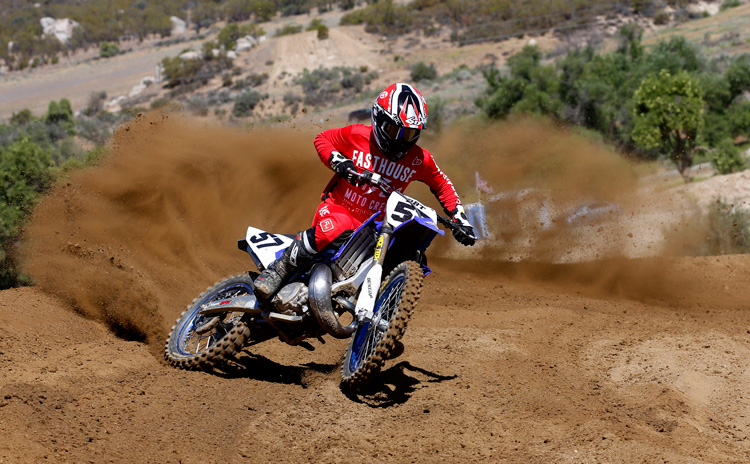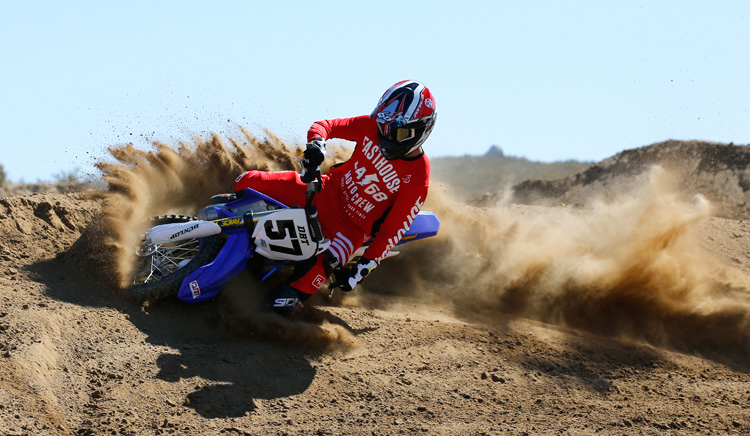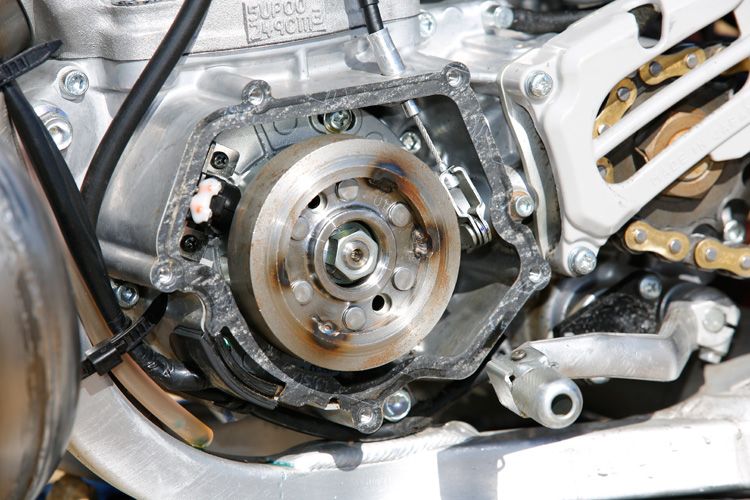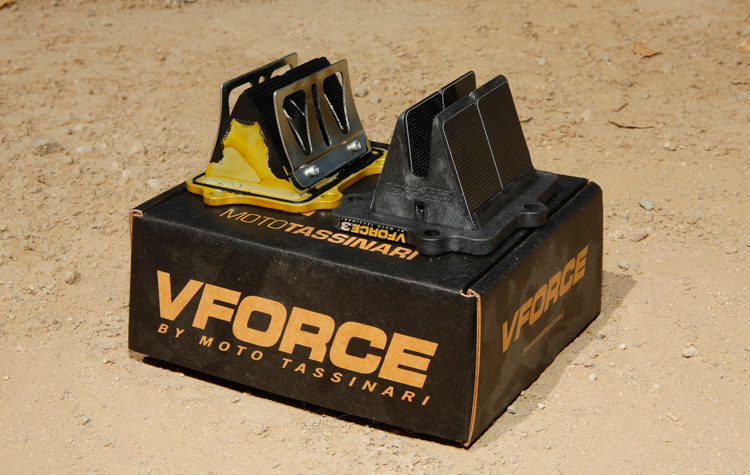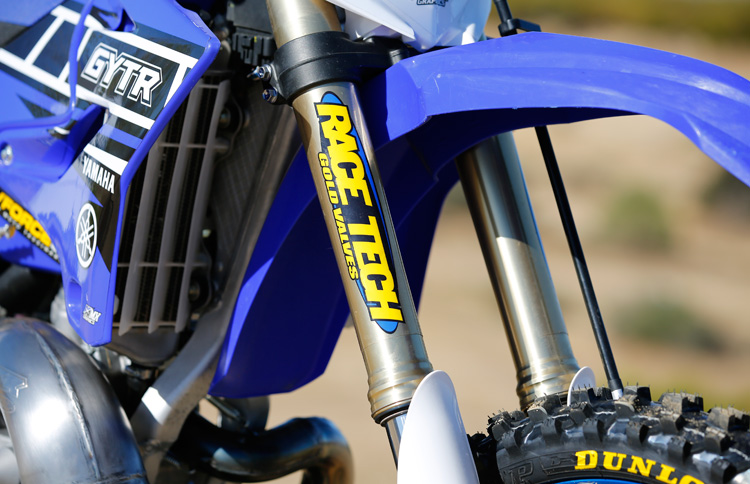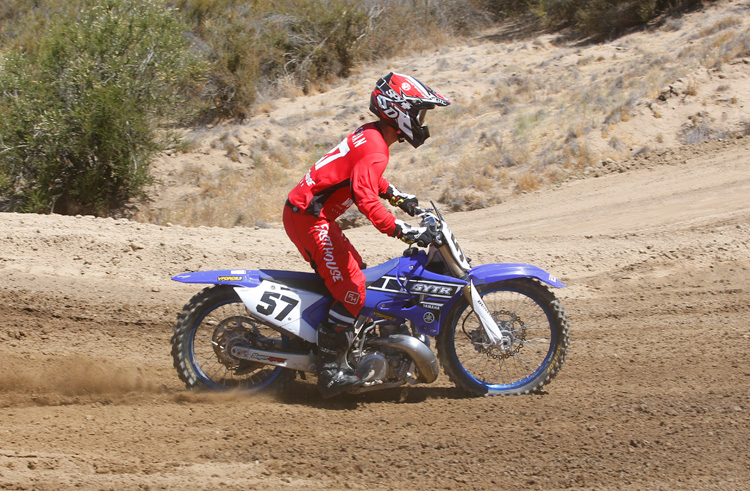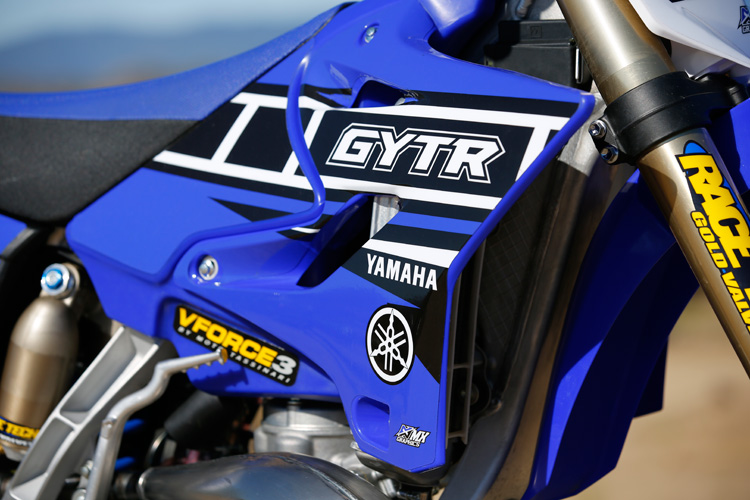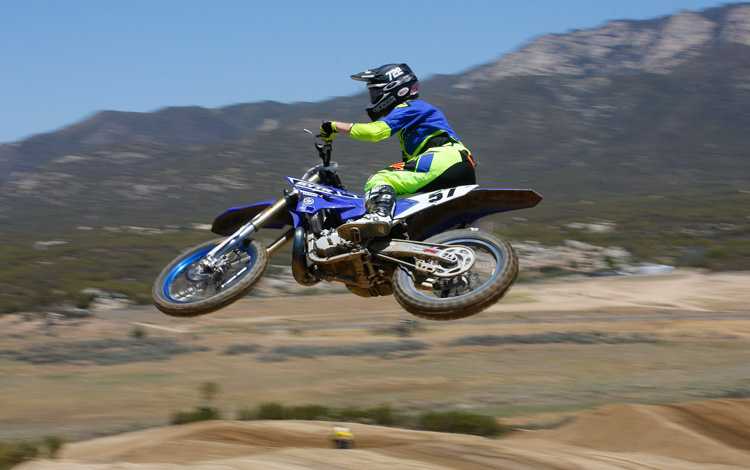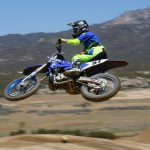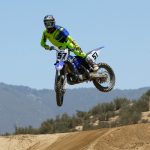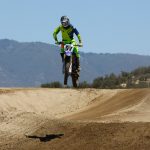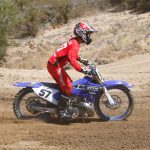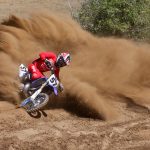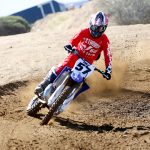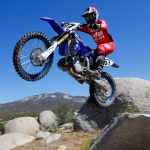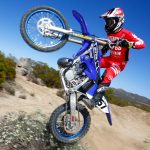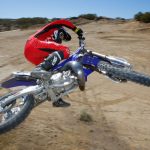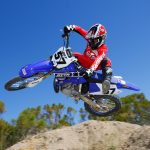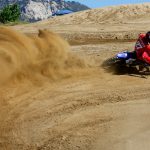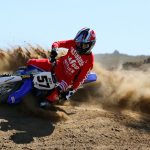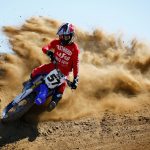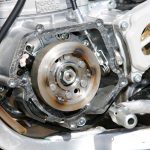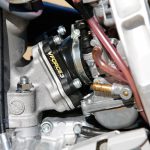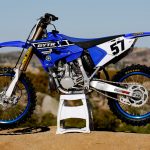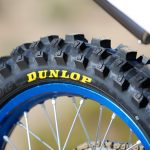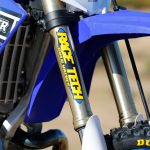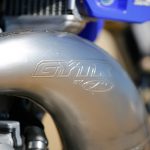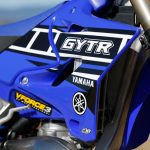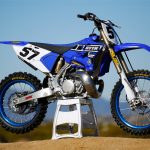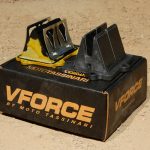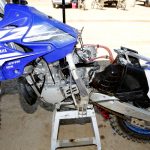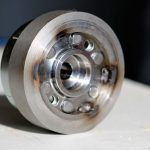GYTR, Race Tech, Dunlop, V-Force Project 2018 Yamaha YZ250
Story, Photos and Test Riding by the firm of Hoffman Hoffman & Hoffman; Scott, Dustin and Travis (not related)
Imagine never knowing what it’s like to ride a 250 two-stroke, a machine that dominated motocross for over 30 years. I was a little blown away that there are a slew of riders that have never felt the bark, hard-hitting, clutch-slipping hit of a full-sized smoker. Most Millennial racers may have grown up riding an 85cc but transitioned to 250Fs and never mixed fuel again.
The smokers, although rarer these days, have seen a resurgence in certain regions, especially with heyday-era model restorations from the late ’70s to late ’80s. Yet every week there are those die-hards that love the feel of a two-stroke and at times you’ll see a youngster aboard a 125 flogging the snot out of his ride while blowing past 450s. It’s funny that it’s almost a novelty when we watch a factory rider take some laps on a two-stroke—some people go crazy for it.
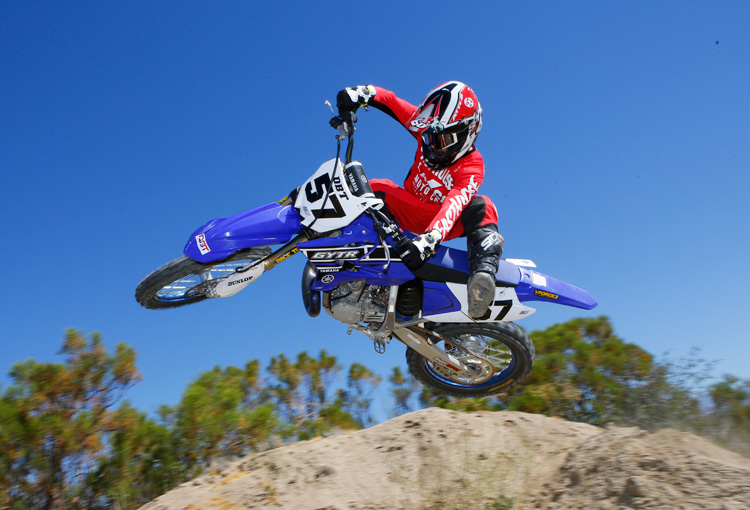 Dustin Hoffman whips the YZ250 smoker just because its fun
Dustin Hoffman whips the YZ250 smoker just because its fun
Yamaha refuses to toss in the towel unlike every other Japanese manufacturer with regard to full-sized, two-stroke motocross and off-road bikes. Yes, their YZ250 is a little dated since the basic chassis saw its last full update in 2005, and the engine’s even a little older than that. Over the years, the 250 has seen some updates to suspensions, springs, exhaust, jetting, and a cosmetic update a few years back but, for the most part, it’s a very similar bike going back 17 years.
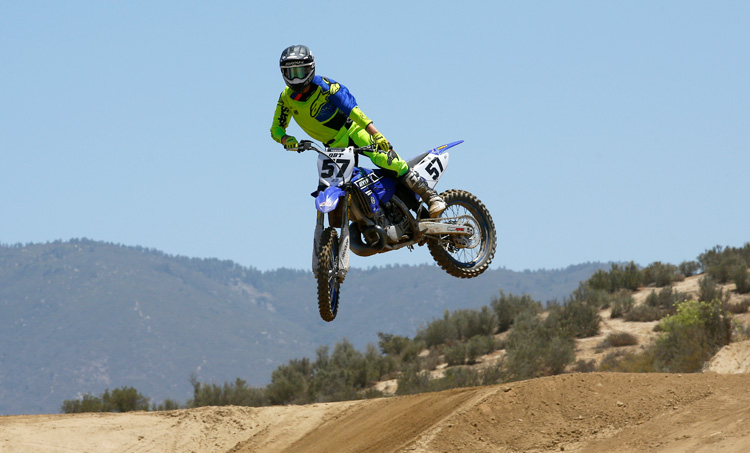 Travis Hoffman also had his turn on the YZ250, his steady steed is a KTM250SX
Travis Hoffman also had his turn on the YZ250, his steady steed is a KTM250SX
However, don’t let its age hinder any notion that it’s not a really fun and competitive motorcycle. Since I had ridden these bikes over the years from time to time, it didn’t take more than a day to get reacquainted with this old friend, and I was grinning every time I rode it. Don’t get me wrong, it takes a little more work and you can’t be as lazy hitting your marks or being in the right gear but when you get it down, it’s a blast to ride. Not to mention the chassis is so much lighter feeling if you’ve been riding a 450 for a long spell. Riding a 250 2T, the slightly added work doesn’t really expel any more energy, it’s almost less when riding hard compared to the heavier-feeling 450. The YZ250 is so much fun to ride, I actually own one.
The YZ250 is a solid and competitive machine and can easily be made better with minimal mods, although like any bike, you can go crazy depending on your budget. The YZ is a little dated with the power delivery compared to the Euro smokers, which have made a few leaps forward. The power is a little old-school two-stroke and because I am a little heavier than the target audience, some suspension work was in line.
We wanted to keep the project within a real-world budget and forego a long list of bling and stuff that’s not always necessary but sometimes nice. This is also why this project is so great, because there have been many YZ250s sold over the years, and they don’t differ too much, most of these mods carry over to the 2019 models all the way back to 2006, the first year of the KYB SSS fork.
We turned to Yamaha’s GYTR accessory division for basic bolt-on items to help broaden the power and spread out the hit in the middle. The stock engine hits hard and there was a time when this is what everyone wanted. Yet four-strokes have changed the way people ride and broader power is easier to manage. Myself and a few of our test riders all felt the YZ had a tendency to hit hard and rev through the power too fast. Riders also had to use a lot of clutch exiting corners to keep the engine on the pipe and/or not wheelie while exiting corners. Creating a power delivery that was broader and easier to ride for the masses was the number-one goal. Yes, the YZ is a little underpowered compared the KTM and Husky but it was never a real issue and we wanted to keep the bike reliable and not have to run full-race fuel every time we rode.
Engine
The easiest solution (or part of the solution) and one that dates back to when Chad Reed raced the YZ250, happens to be a flywheel weight. Yes, even Reed wanted more tractable power and a flywheel weight was on his factory bike. GYTR offers an 8oz flywheel that bolts on in a few minutes if you have a puller and impact driver. Dollar for dollar ($158.99 retail) this was the best mod to broaden the hit and improve traction in the mid-range. Why Yamaha has not updated the production YZ250 with this mod is a little baffling. If you ride a stock YZ250, this would be first mod before an exhaust or reed cage.
Speaking of reed cages, the second mod from GYTR (although we got ours direct from Moto Tassinari) is the VForce3. We added the cage along with the flywheel, but we first tested the combo with the stock exhaust and silencer. The cage bolts up pretty easy but we did have to remove the silencer, pull the shock, lower the subframe to get easy access to remove the carburetor and access the intake manifold. It’s probably a 1-hour project or a little longer if you take your time to double check everything. With the cage, you do lose a tiny, tiny bit of low rpm torque but from there the cage keeps the engine pulling more in the mid and there are noticeable gains as the power ramps up into the top end and revs out further without falling flat or signing off as fast. We ran our cage with the stock reed cage spacer because our original goal was to smooth out the hit and broaden the mid-range.
To round out our mods, we went with the GYTR/FMF exhaust and silencer. We had a small dent in our stock exhaust from hitting a rock while riding off-road and we also wanted the look of an aftermarket exhaust. The GYTR/FMF system is a little lighter than stock but not enough to make a big difference. The system did sound a little more throaty and barked a little louder on the track. The pipe did take a little low bottom away but down in the RPM range we never really use when riding moto. The pipe did take that low and moved it across the board and again helped improve the pull slightly into the mid and built the power a little faster from mid-top. The stock exhaust works pretty good so we were not expecting drastic gains, although we did notice the difference in mid-top pull. More aggressive riders, or riders who like to rev the snot out of the engine, will like the exhaust. The silencer does look way better than stock and sounds throatier but there was little to no change in the power delivery that we could tell from the seat of our pants. We tested the total combo with the stock and GYTR/FMF muffler and other than maybe a little snappier throttle response, the overall power delivery was the same. Back in the day, David Vuillemin used to run his Factory YZ250 with an FMF exhaust hooked to a Pro Circuit silencer.
Jetting was pretty spot on but we did have to dial in the airscrew and run a leaner pilot depending on the track. We also rode a few times with a mix of VP C-12 and pump fuel 50/50 and the engine was a little crisper and ran slightly stronger but we never had any real detonation issues with just straight pump fuel. Your jetting may vary. We did most of our testing during the hot season in Southern California.
Suspension
The stock suspension on the YZ250 is still a solid combination. Even though the fork and shock are essentially from 2006, the components are still very similar to what is currently on the F models, except the shock body and shaft are slightly smaller on the YZ250. The internals of the Kayaba SSS fork were updated a few years back to the same units as the YZ250F and YZ450F, although with their own spring rate and valving. Because we had some hours on our bike and the spring rates were a little soft, Race Tech was our next stop. Instead of just going in for a standard rebuild and spring rates, RT updated the valving to their Gold Valve setup and their line of springs front and rear. They often run stiffer spring rates than some so the fork and shock valving can control the suspension action through bumps and hits and allow the springs to take on the ride height and major forces. We had really good results with Race Tech in the past and they did us another real solid.
For us the stock settings rode too low in the stroke, especially in the fork, and would upset the chassis and the bike would dance around in some chop or rough sections. We started with just going to a 5.2kg shock spring, which helped but after the full RT setup it was miles better for our 190-205-lb riders. Race Tech upped the fork spring to .48kg/mm from .44kg/mm and in the rear went from a 4.9kg/mm to 5.8kg/mm. Race sag was set right around the 103mm range, slightly more for tracks with lots of chop or fast sections.
Race Tech changes a lot of internal components with their signature Gold Valves in the fork and shock. The most improvement came in the shock. The new settings really helped the rear wheel connection to the ground under acceleration and when hitting square-edge bumps and holes. The stock shock has a tendency to deflect and the rear wheel can dance, especially while exiting rough corners. The rear now tracks better and is calmer and inspires confidence in the rider. The fork does help keep the bike more balanced and there is less pitch front to back while riding with the new settings. Bottoming control has been improved. Overall, the action has been improved but there was a slight give in plushness with the stiffer settings in some mid-stroke braking bumps. For the most part, we were willing to give up a little in one section for the overall performance. The feel on slap-down landings is better, it holds up better in whoops and consecutive hits, so the tradeoff in some braking bumps was not a big issue. You can back off the compression to help but you end up giving up some action that works so well in other sections of the track.
When we rode the bike stock, the first thing we disliked were the stock tires, the Dunlop MX52. Not bad but they don’t seem to gel with the YZ on several California tracks. For our project, we updated them with the new Dunlop MX33 tires, which, believe it or not, seemed to work way better with the chassis and made the front end feel better and less harsh in chop. Other updates were to replace the wornout chain and sprocket with SuperSprox components including a sealed x-type chain. To cap off the project, MX Graphics updated the look with custom shroud and number plate backgrounds.
The one item we wish we had pulled the trigger on was either some sort of top triple clamp with cone-style rubber mounts or maybe an XTRIG bar mount with rubber dampers. The slight added hand and arm comfort would allow us to cushion some harsh hits a little and still allow us to run firm suspension settings.
Final Thoughts
The YZ250 is a workhorse and still going strong after all these years. The cost to keep a two-stroke running strong is way more cost effective if you plan on putting more than 80-100 hours on a bike. If you plan on keeping a bike for years and years, the overall cost of maintenance could be thousands if a total rebuild is needed.
Riding the YZ250 is so much fun and even racing one is a blast. On the track, our lap times were about the same regardless if we were riding a 450 or the 250 smoker, at least for our ability.
The YZ250 is not the best turning bike in today’s field but with some simple mods you can help bring some items up to date and it won’t break the bank. Our mods were simple bolt-on engine updates to make the engine easier and even more fun to ride for the average rider. The suspension work was in need of maintenance and dialing it in for our rider made the overall build that much better in the long run. Another added bonus is that the YZ250 can also cross over to a pretty good off-road bike with the addition of a spark arrestor. It’s one of those bikes you can ride in the desert one weekend, the mountains the next, and the track the third. For some, the YZ250 could be your dedicated ride in the garage and an option not to be overlooked. Even having one as second bike you ride for fun on some weekends is an option and the option we chose. No matter how you do it—pick up a used bike or a brand-new model—the YZ250 experience is something to enjoy if you like to ride.
The List:
Yamaha:
GYTR 8oz Flywheel Weight $158.99
GYTR/FMF Exhaust $255.99
GYTR/FMF Silencer $134.99
Moto Tassinari:
VForce3 $161.99
Race Tech:
RT Revalve fork/shock: $250.00
RT Gold Valves fork/shock ($169 each) $507.00
RT Fork Springs, .46kg/mm $130.00
RT Shock Spring, 5.8kg/mm $119.99
RT parts and oil $64.97
Dunlop:
80/100-21 MX33 front See Dealer
110/90-19 MX33 rear See Dealer
SuperSprox:
Rear aluminum $54.95
Countershaft $19.95
Chain $84.99
MX Graphics:
Shroud/Tank graphics, (Retro 2.0) $65.00
Number plate background, (Original series) $45.00
LINKS:
Yamaha USA/GYTR
Moto Tassinari
Race Tech Suspension
Dunlop Motorcycle Tires
SuperSprox USA
MX Graphics

